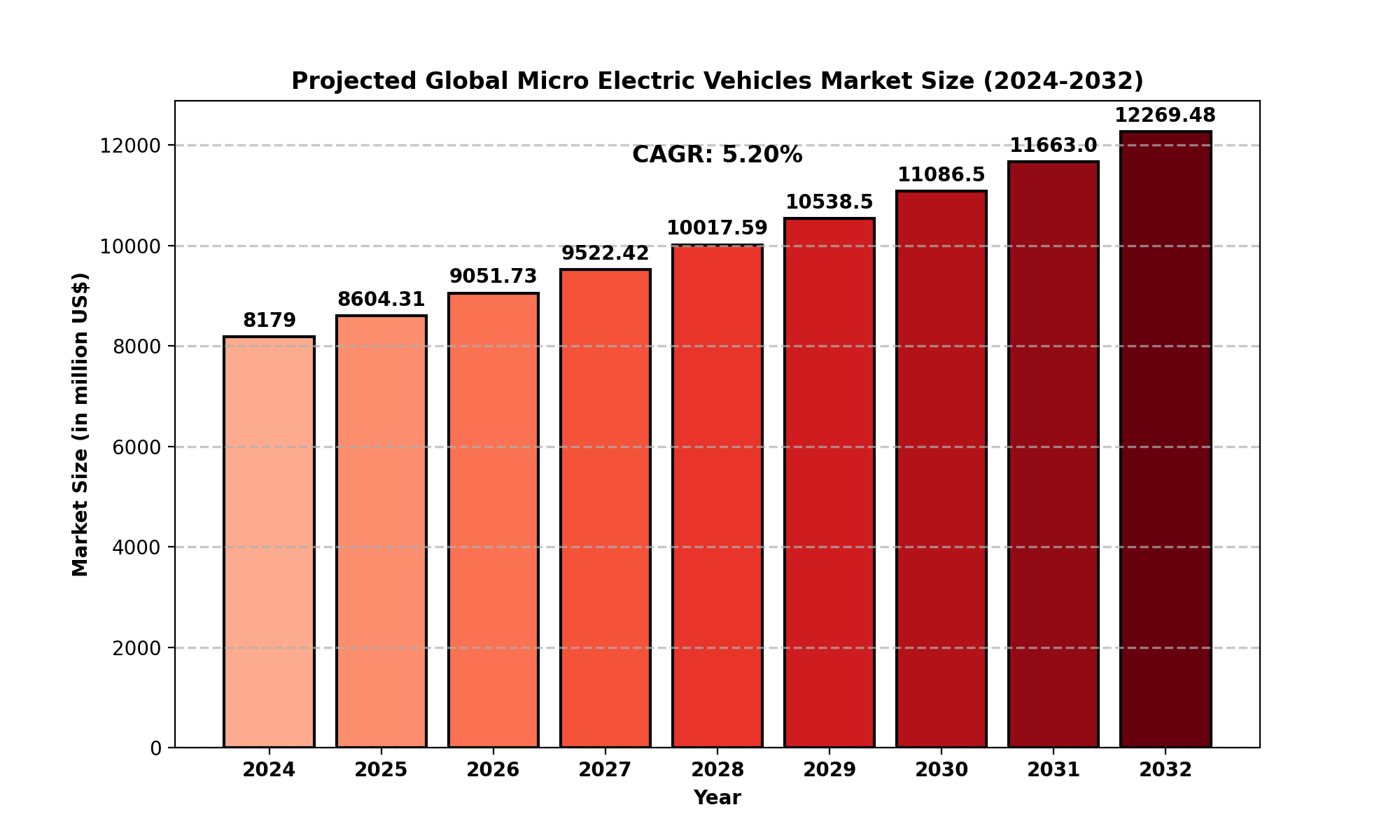TOP CATEGORY: Chemicals & Materials | Life Sciences | Banking & Finance | ICT Media

Download Report PDF Instantly
Report overview
Micro Electric Vehicles (EVs) are compact, energy-efficient vehicles that provide an eco-friendly alternative for short-distance travel. These vehicles are designed to be more space-efficient and offer a sustainable mode of transport in urban environments. They typically feature a low-powered drivetrain, a compact battery system, and offer a range of about 200 km on a single charge. The top speed of micro EVs generally ranges between 60 to 100 km/h, making them ideal for city commutes and short-distance trips.
Micro EVs come in two major types: pure electric and hybrid electric. Pure electric micro EVs run entirely on electric power, while hybrid models combine an electric motor with a traditional combustion engine, offering better range and flexibility for users.
Micro EVs are ideal for those looking for a low-cost, environmentally friendly, and efficient alternative to conventional vehicles. Their compact size allows them to be used in crowded city areas where space is limited, contributing to reduced traffic congestion and pollution.
The global Micro Electric Vehicles market is experiencing significant growth. As of 2024, the market size was estimated at USD 8,179 million and is projected to reach USD 12,269.48 million by 2032. This growth is expected to occur at a Compound Annual Growth Rate (CAGR) of 5.20% during the forecast period.
Several factors contribute to this growth, including advancements in battery technology, government initiatives to promote electric mobility, and the increasing demand for sustainable transport solutions. The growing awareness of climate change and air pollution is also pushing consumers towards cleaner alternatives like micro EVs.
The demand for micro EVs is anticipated to continue to rise, particularly in regions with stringent emission regulations and policies that promote electric mobility. Micro EVs' affordability, coupled with the growing network of EV charging infrastructure, is further driving the market’s expansion.

Drivers
Rising Environmental Concerns: As awareness of climate change and environmental pollution increases, consumers are seeking eco-friendly transportation options, including micro EVs.
Government Support: Many governments worldwide are providing incentives, subsidies, and rebates for electric vehicle purchases, which significantly enhances the adoption rate of micro EVs.
Urbanization and Traffic Congestion: With cities becoming more densely populated, the demand for compact and efficient vehicles like micro EVs is surging. These vehicles offer a perfect solution to crowded urban environments.
Technological Advancements: Innovations in battery technology and improvements in energy efficiency have made micro EVs more affordable and practical for daily use.
Restraints
Limited Range: Micro EVs typically offer a limited driving range compared to traditional electric or gasoline-powered vehicles, which may not meet the needs of long-distance commuters.
Charging Infrastructure: Although EV charging stations are increasing, the lack of widespread and convenient charging infrastructure remains a challenge in some regions.
High Initial Cost: The upfront cost of micro EVs, although generally lower than conventional electric cars, may still be a deterrent for some consumers, particularly in developing regions.
Opportunities
Expansion in Emerging Markets: Countries in Asia, Africa, and South America are expected to become significant markets for micro EVs as their economies develop and demand for sustainable transport increases.
Integration with Smart Cities: Micro EVs are well-suited for integration into smart city initiatives, which focus on reducing emissions, improving traffic flow, and enhancing sustainability.
Autonomous Micro EVs: The development of autonomous driving technology presents new opportunities for micro EVs, particularly in shared mobility services.
Challenges
Competition from Other EV Segments: The micro EV market faces competition from larger electric vehicles and hybrids, which may offer more power, range, and features.
Battery Life and Durability: Battery performance remains a significant challenge, as micro EVs depend heavily on battery technology for efficiency and range. Managing battery longevity and minimizing degradation will be key to ensuring the market’s sustainability.
Regulatory and Safety Concerns: Regulatory policies regarding vehicle safety standards and emissions regulations are constantly evolving, and companies must comply with these regulations to avoid fines and market restrictions.
North America
The North American micro EV market is experiencing steady growth, with the U.S., Canada, and Mexico leading the way. Government incentives, such as tax credits for electric vehicles, have boosted the adoption of EVs. However, the micro EV segment faces strong competition from traditional electric vehicles like Tesla, which offer better performance and range. Despite this, micro EVs are expected to grow at a CAGR of 4.46% between 2025 and 2032.
Europe
Europe is one of the largest markets for micro EVs, driven by the region’s aggressive environmental policies, high urbanization rates, and government subsidies. Countries like the UK, France, and Germany are leading the way in adopting electric vehicles, including micro EVs. The European Union's stringent emissions targets are pushing consumers and businesses toward cleaner transportation options.
Asia-Pacific
Asia-Pacific is expected to dominate the global market due to the large population, rapid urbanization, and government support for green transportation. China, Japan, and India are significant players in the micro EV market. China, in particular, has become a hub for electric vehicle production, and its policies favoring electric mobility continue to drive market growth.
South America
In South America, the micro EV market is still in its nascent stage but is expected to grow as the demand for sustainable transport solutions increases. Brazil and Argentina are expected to lead the region's market as they begin to implement more pro-electric vehicle policies.
The Middle East and Africa
The market in the Middle East and Africa remains relatively small, but there are growing efforts to integrate electric vehicles into the region. Countries like the UAE and South Africa are gradually adopting electric mobility as part of their sustainability goals.
Several global players dominate the micro electric vehicles market, including:
Tesla: Known for its high-performance electric vehicles, Tesla has expanded its offerings to include smaller, more affordable EVs. Its innovative battery technology and autonomous driving capabilities give it a competitive edge.
Renault: Renault has been a key player in the electric vehicle market, offering models such as the Renault Twizy, which has captured significant attention for urban commuting.
Toyota: Toyota has entered the micro EV market with models designed for short-distance travel. Its commitment to sustainability and innovation gives it a strong position in the market.
BMW: BMW's i3 has been one of the more well-known micro EVs, offering an upscale, eco-friendly driving experience.
Audi and Ford: Both companies have shown interest in developing compact electric vehicles to cater to urban markets and increase their EV market share.
This report provides a deep insight into the global Micro Electric Vehicles market, covering all its essential aspects. This ranges from a macro overview of the market to micro details of the market size, competitive landscape, development trend, niche market, key market drivers and challenges, SWOT analysis, value chain analysis, etc.
The analysis helps the reader to shape the competition within the industries and strategies for the competitive environment to enhance the potential profit. Furthermore, it provides a simple framework for evaluating and assessing the position of the business organization. The report structure also focuses on the competitive landscape of the Global Micro Electric Vehicles Market. This report introduces in detail the market share, market performance, product situation, operation situation, etc., of the main players, which helps the readers in the industry to identify the main competitors and deeply understand the competition pattern of the market.
In a word, this report is a must-read for industry players, investors, researchers, consultants, business strategists, and all those who have any kind of stake or are planning to foray into the Micro Electric Vehicles market in any manner.
Household: Micro EVs are increasingly being used for household purposes, especially in urban areas where short trips are common. These vehicles offer a convenient, cost-effective mode of transportation for daily commuting and local errands.
Commercial: Commercial applications for micro EVs are gaining traction, particularly in fleet operations for last-mile delivery services, taxis, and shared mobility solutions. Their affordability and efficiency make them ideal for businesses looking to cut costs and reduce emissions.
Pure Electric: These vehicles run entirely on electricity and require no gasoline or diesel fuel. They are eco-friendly and efficient for short-distance trips.
Hybrid Electric: Hybrid electric micro EVs combine an electric motor with a traditional internal combustion engine, providing greater range and flexibility.
Tesla
Renault
Toyota
BMW
Audi
BYD
Ford
Honda
Alta
E-Rex
Jinhua
Sanyo System
North America (USA, Canada, Mexico)
Europe (Germany, UK, France, Russia, Italy, Rest of Europe)
Asia-Pacific (China, Japan, South Korea, India, Southeast Asia, Rest of Asia-Pacific)
South America (Brazil, Argentina, Columbia, Rest of South America)
The Middle East and Africa (Saudi Arabia, UAE, Egypt, Nigeria, South Africa, Rest of MEA)
1. What is the current market size of the Micro Electric Vehicles market?
2. Which are the key companies operating in the Micro Electric Vehicles market?
3. What are the key growth drivers in the Micro Electric Vehicles market?
4. Which regions dominate the Micro Electric Vehicles market?
5. What are the emerging trends in the Micro Electric Vehicles market?